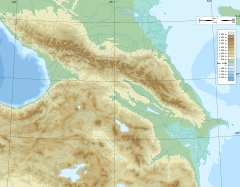geo.wikisort.org - River
The Baksan, also known as Azau (Russian: Баксан, Азау) is a river in Kabardino-Balkaria in Russia. It flows east northeast and joins the Malka just before that river joins the northwest bend of the Terek. The Baksan is 169 kilometres (105 mi) long, with a drainage basin of 6,800 square kilometres (2,600 sq mi).[1]
| Baksan | |
|---|---|
 | |
 | |
| Location | |
| Country | Kabardino-Balkaria (Russia) |
| Physical characteristics | |
| Source | Lateral Range Mount Elbrus |
| • location | Greater Caucasus |
| Mouth | Malka |
• coordinates | 43.7331°N 44.0633°E |
| Length | 169 km (105 mi) |
| Basin size | 6,800 km2 (2,600 sq mi) |
| Basin features | |
| Progression | Malka→ Terek→ Caspian Sea |
Course
The Baksan originates in the Azau glacier, on the south slopes of Mount Elbrus. Notable tributaries are the Chegem and the Cherek.[1] On your ascent of the river, Baksan town and Tyrnyauz lie alongside it, and there is a 25 MW hydropower plant on the river.[2][3] The A158 roadway lies beside it, and bestrides it several times on the way up to Nationalpark Elbrus.
Baksan is also the site of the Baksan Underground Scintillation Telescope (BUST) of the Baksan Neutrino Observatory.[4]
Photo Gallery
- Stormy Baksan
- Forest on the bank of Baksan
References
- "Река Баксан (Азау) in the State Water Register of Russia". textual.ru (in Russian).
- "Baksan River" (in Russian). Great Soviet Encyclopedia. Retrieved January 30, 2016.
- "Baksan River Hydro" (in Russian). Baskan HPP. Retrieved January 30, 2016.
- "Baksan Neutrino Observatory" (in Russian). Baskan Neutrino Observatory. Retrieved January 30, 2016.
External links
На других языках
[de] Baksan (Fluss)
Der Baksan (russisch Бакса́н, karatschai-balkarisch Басхан) ist ein 173 km langer rechter Nebenfluss der Malka in der nordkaukasischen Republik Kabardino-Balkarien in Russland.- [en] Baksan (river)
[it] Baksan (fiume)
Il Baksan (in russo Баксан; in caraciai-balcaro Басхан) è un affluente di destra del Malka lungo 173 km che scorre nella repubblica ciscaucasica della Cabardino-Balcaria, in Russia.[ru] Баксан (река)
Бакса́н[2] (кабард.-черк. Бахъсэн, карач.-балк. Басхан) — река на Северном Кавказе в Кабардино-Балкарской Республике. Правый приток Малки (бассейн Терека). Верховье реки у истока, иногда встречается под названием Азау[2]. Средний расход воды — 33,6 м³/с.[источник не указан 344 дня]Другой контент может иметь иную лицензию. Перед использованием материалов сайта WikiSort.org внимательно изучите правила лицензирования конкретных элементов наполнения сайта.
WikiSort.org - проект по пересортировке и дополнению контента Википедии



